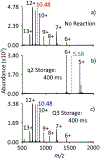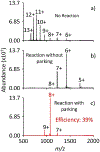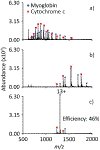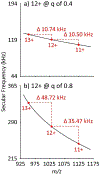Valet Parking for Protein Ion Charge State Concentration: Ion/Molecule Reactions in Linear Ion Traps
- PMID: 32100997
- PMCID: PMC7145756
- DOI: 10.1021/acs.analchem.0c00146
Valet Parking for Protein Ion Charge State Concentration: Ion/Molecule Reactions in Linear Ion Traps
Abstract
There are several analytical applications in which it is desirable to concentrate analyte ions generated over a range of charge states into a single charge state. This has been demonstrated in the gas phase via ion/ion reactions in conjunction with a technique termed ion parking, which can be implemented in electrodynamic ion traps. Ion parking depends upon the selective inhibition of the reaction of a selected charge state or charge states. In this work, we demonstrate a similar charge state concentration effect using ion/molecule reactions rather than ion/ion reactions. The rates of ion/molecule reactions cannot be affected in the manner used in conventional ion parking. Rather, to inhibit the progression of ion/molecule proton transfer reactions, the product ions must be removed from the reaction cell as they are formed and transferred to an ion trap where no reactions occur. This is accomplished here with mass-selective axial ejection (MSAE) from one linear ion trap to another. The application of MSAE to inhibit ion/molecule reactions is referred to as "valet parking" as it entails the transport of the ions of interest to a remote location for storage. Valet parking is demonstrated using model proteins to concentrate ion signal dispersed over multiple charge states into largely one charge state. Additionally, it has been applied to a simple two-protein mixture of cytochrome c and myoglobin.
Figures








Similar articles
-
Ion parking during ion/ion reactions in electrodynamic ion traps.Anal Chem. 2002 Jan 15;74(2):336-46. doi: 10.1021/ac0109671. Anal Chem. 2002. PMID: 11811406
-
A linear ion trap mass spectrometer with versatile control and data acquisition for ion/ion reactions.J Am Soc Mass Spectrom. 2008 Dec;19(12):1821-31. doi: 10.1016/j.jasms.2008.08.020. Epub 2008 Sep 6. J Am Soc Mass Spectrom. 2008. PMID: 18838277
-
Protein identification via ion-trap collision-induced dissociation and examination of low-mass product ions.J Mass Spectrom. 2008 Jan;43(1):23-34. doi: 10.1002/jms.1263. J Mass Spectrom. 2008. PMID: 17613176
-
'Top down' protein characterization via tandem mass spectrometry.J Mass Spectrom. 2002 Jul;37(7):663-75. doi: 10.1002/jms.346. J Mass Spectrom. 2002. PMID: 12124999 Review.
-
Ion/ion chemistry of high-mass multiply charged ions.Mass Spectrom Rev. 1998 Nov-Dec;17(6):369-407. doi: 10.1002/(SICI)1098-2787(1998)17:6<369::AID-MAS1>3.0.CO;2-J. Mass Spectrom Rev. 1998. PMID: 10360331 Review.
Cited by
-
Single-Frequency Ion Parking in a Digital 3D Quadrupole Ion Trap.Int J Mass Spectrom. 2024 Sep;503:117282. doi: 10.1016/j.ijms.2024.117282. Epub 2024 Jun 25. Int J Mass Spectrom. 2024. PMID: 39006163
-
Precursor Resolution via Ion Z-State Manipulation: A Tandem Mass Spectrometry Approach for the Analysis of Mixtures of Multiply-Charged Ions.J Mass Spectrom. 2025 May;60(4):e5124. doi: 10.1002/jms.5124. J Mass Spectrom. 2025. PMID: 40159668 Free PMC article. Review.
-
Recent Advances in Mass Spectrometry-Based Structural Elucidation Techniques.Molecules. 2022 Sep 30;27(19):6466. doi: 10.3390/molecules27196466. Molecules. 2022. PMID: 36235003 Free PMC article. Review.
-
Ion parking in native mass spectrometry.Analyst. 2024 May 13;149(10):2966-2977. doi: 10.1039/d4an00242c. Analyst. 2024. PMID: 38600834 Free PMC article.
References
-
- McLuckey SA, Goeringer DE: Ion/Molecule Reactions for Improved Effective Mass Resolution in Electrospray Mass Spectrometry. Anal. Chem 67, 2493–2497 (1995) - PubMed
-
- Stephenson JL Jr, McLuckey SA: Charge manipulation for improved mass determination of high-mass species and mixture components by electrospray mass spectrometry. J. Mass Spectrom 33, 664–672 (1998) - PubMed
Publication types
MeSH terms
Substances
Grants and funding
LinkOut - more resources
Full Text Sources

